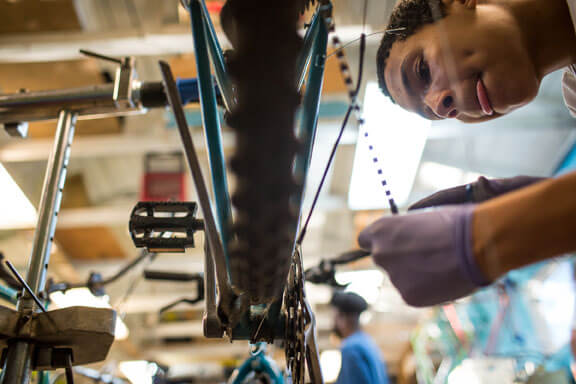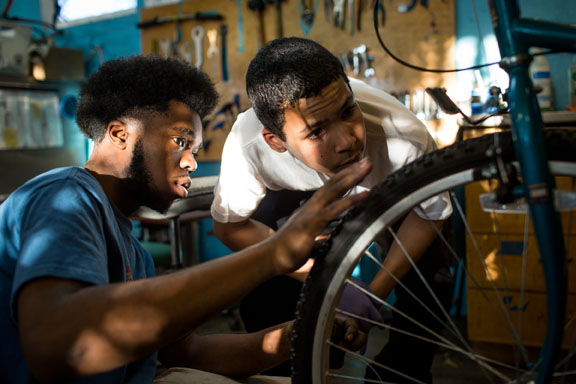
Intern David Diarra, 15, works on a bike at Street Level Cycles a part of Waterside Workshops in Berkeley, California. Photo: Max Whittaker, Prime Collective
Intro / Part One / Part Two / Part Three / Part Four / Part Five / Part Six / Part Seven / Close
Today, we officially conclude “Positive Youth Justice: Curbing Crime, Building Assets,” a series that imagines an entire juvenile justice system built on the positive youth development (PYD) framework.
Central to this series were profiles of five PYD-oriented programs that serve youth at different points along the juvenile justice continuum: prevention, diversion, community corrections, incarceration and re-entry.
None of these programs served the same community. But imagine if they did.
Imagine one county, or city, that geared every stop on that line toward building the assets of the kids and teens in front of them. Where runaway and homeless youth were engaged on that level before they crossed paths with law enforcement. Where kids who admitted guilt were offered the chance to make things right with victims.
Where high-risk youth were paired with professional advocates in their own communities, and connected with jobs and the skills to succeed in the working world. Where the most serious offenders received aggression replacement training and apprenticeship opportunities while they are locked up.
And where youth who came home from incarceration were connected with a deeply caring and nonjudgmental staff hell-bent on helping them move forward.
This is the picture that comes into view if one imagines all of our profiled programs occurring in the same place. It would be a system that, at every step along the way, saw youth as resources to be strengthened instead of victims or villains.

A white board at Santa Clara County Probation Department’s William F. James Ranch for juvenile offenders in Morgan Hill, California. Staff here strives to provide a therapeutic, home-like environment. Photo: Max Whittaker, Prime Collective
It is a vision that does not require an end to incarceration. It certainly does not supplant or diminish the services needed to address the deficits of many juveniles; substance abuse, mental health needs and trauma chief among them.
It is a vision that begins with two simple questions: What interests this child or young person, and how can we use those interests to build him or her up?
Following are a few themes that emerged as we at The Imprint constructed this imaginary “Positive Youth Justice System.”
Relationships Equal Flexibility
In Oakland, community conferencing leader sujatha baliga got law enforcement and prosecutors to sign off on a “Reverse Miranda” that enabled youth to speak freely during the restorative justice process.
In Santa Clara, leaders at the William F. James Ranch secured an agreement from the court that enabled them to handle facility incidents and parole violations without bringing new formal charges.
The common denominator: Relatively modest concessions, built on trust, helped PYD programs succeed. Without the Reverse Miranda, the open discussion necessary for community conferencing is challenged.
Without some flexibility to move kids in and out of the James Ranch to improve their chances at development, a lot of offenders might end up locked in juvenile hall or adult jail instead of holding steady jobs.
Time for A National Recidivism Standard
Waterside Workshops, the final organization we profiled, is the rarest of birds in juvenile justice in that it receives no government funding. Co-founders Amber Rich and Helder Parreira are free to gauge their success however they like.
For the rest of the juvenile justice provider world, the main measure is and always will be recidivism. Some champions of PYD will blanche at that statement, but it is reality. From the government funder’s perspective, taxpayer money directed at this field is headed out the door to stop youth from committing more crimes.
The problem is that using recidivism as a unit of measurement gives an illusion of consistency where none exists. Certain states and counties call a subsequent arrest recidivism; others only consider it recidivism when a subsequent conviction occurs. Some systems track recidivism six months or a year after completion of a program or sentence; others at three years.
It is long past time for a common, consensus approach to the most important metric in juvenile justice. The Office of Juvenile Justice and Delinquency Prevention funded an effort to develop national recidivism calculations in the late 2000s; nothing came of it.
It goes beyond the basic math formula; there needs to be some consensus about what constitutes “success” from a recidivism standpoint. Is a 35 percent recidivism rate good? Maybe not if you are running a diversion program for first-time offenders.
Maybe if your program handles mostly juvenile felons with long records, 35 percent is unbelievably good compared to what came before.

Marsalis Johnson, a former intern and now mechanic, left, helps intern David Diarra, 15, right, work on a bike at Street Level Cycles a part of Waterside Workshops in Berkeley, California, February 20, 2015.
Other Measures Needed
The national conversation on measuring success in juvenile justice should go beyond recidivism and establish a set of nationally acceptable metrics by which systems could measure the impact of programs and facilities.
However it is measured, recidivism should not be the lone metric that matters. As Marc Schindler described in his contribution to the series:
“Preventing future contact with the system is obviously a very important goal. But most parents don’t just ask that their kids avoid being arrested or pass a drug test—we hope that our kids will positively engage with pro-social activities, meaningful relationships and develop skills to guide them through life.”
A few areas where concrete ways to measure are needed:
- Academic achievement
- Improved communication in the family
- Addressing psychosocial problems such as loneliness or hopelessness
- Increased self-esteem and personal control
- Development of life skills, decision-making ability, and job responsibility
- Most likely, adoption of such metrics would steer systems in the direction of PYD-oriented policies and providers.

Motivational wall art in a classroom at Santa Clara County Probation Department’s William F. James Ranch for juvenile offenders in Morgan Hill, California. Staff here strives to provide a therapeutic, home-like environment. Photo by Max Whittaker, Prime Collective.
Funding to Follow
Positive youth development is hardly a new concept, but its use in juvenile justice settings and systems is infrequent and largely undocumented.
It is no surprise, then, that funding for ventures that intersect the two is scarce and erratic. The community conferencing program we profiled is producing results, and at the same time figuring out how to fiscally survive past June. The William F. James Ranch has become a model for PYD procedure, but has waited years for funding to improve its physical infrastructure to better help its residents.
The pay-for-success (PFS) model offers significant opportunity for PYD in this sector. PFS projects are funded by private investors who are paid incentives by the government, but only if certain outcomes are achieved. Essentially, the government in question gets a sneak peek at whether something works.
Two organizations involved in our series – the National Council on Crime and Delinquency, and Youth Advocate Programs – are already involved in potential PFS projects. Successful outcomes in these kinds of projects could go a long way to establishing PYD in the juvenile justice framework.
This series was made possible through the support of the Sierra Health Foundation, which has partnered with the California Endowment and the California Wellness Foundation to launch the Positive Youth Justice Initiative to reform the juvenile justice system in four California counties.





